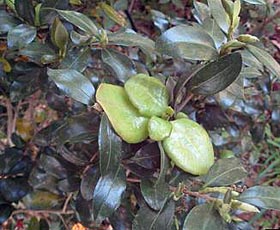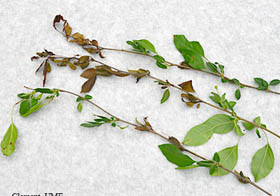The Ugly Side Of May: Plant Disease
By Gil Medeiros, Fairfax Master Gardener Intern
Along with its abundance of flowers, May brings a plethora of plant diseases. Here are three common ones that trouble our mid-spring landscape.
Sycamore Anthracnose

Blighting from the sycamore anthracnose fungus
The anthracnose that plagues sycamore trees gets its start during the cool, rainy weather we see in early spring. Anthracnose might appear on other shade trees, such as maple, oak, or ash, but the specific fungus that infects sycamores, Apiognomonia veneta, affects only sycamores. American sycamores (Platanus occidentalis) are particularly susceptible, but London Plane trees (Platanus x acerifolia) might get it, too. Repeated annual infections may seriously harm the health of the tree.
The disease spores begin in cankers in branches and travel to leaves. The infection spreads along leaf veins and coalesces into large blotches. The leaves eventually fall and weaken the tree. New cankers sometimes appear on twigs in autumn.
You can do little to address the disease now. Rake up and dispose of diseased leaves. For a small tree, prune dead twigs and branches. For a large tree, the pruning will likely require a professional arborist. Fungicides might be effective if applied before and during bud break. Again, when the tree is large, call a professional arborist.
References
VCE Publication 450-609, Anthracnose, A Fungal Disease of Shade Trees, 2009
UMD Extension TPM/IPM Weekly Report for Arborists, Landscape Managers and Nursery Managers, May 17, 2013
Exobasidium Leaf Gall On Camellia

Exobasidium gall on Camellia sasanqua
What are those ugly-looking, thick, fleshy leaves on my camellia? It’s called gall.
Galls are sometimes caused by insects and sometimes by disease. In this case, the fungus Exobasidium camelliae produces the gall. These galls range in color from cream to light green, or sometimes pink to red. Later in the season, white will appear on the lower leaf surface. These are the fungal spores. Spores are little particles of genetic material produced by the fungus to spread the organism. Wind and water send the spores to other parts of this camellia and to nearby plants. The spores remain dormant until spring when the fun starts all over again.
This disease is most commonly seen on fall-flowering camellias, typically Camellia sasanqua. Prune out twigs that show damage, preferably before the white spores appear. This disease should not have a severe effect on the overall health of your camellia.
Reference
UMD Extension TPM/IPM Weekly Report for Arborists, Landscape Managers and Nursery Managers, May 24, 2013
Fire Blight on Trees

Fire blight on tree branches
Unlike the others, fire blight is caused by a bacterium, Erwinia amylovora. Like the others, there is no cure after the disease appears.
Fire blight is a major problem for apple and pear trees, including ornamentals such as crab apple and callery pear. It also affects quince, pyracantha, and sometimes even cotoneaster and rose. Fire blight is one reason it is difficult to grow apples and pears in Fairfax County. Our humid weather provides excellent conditions for the bacterium’s survival.
Fire blight is aptly named: The affected area of the plant looks as if it had been burned in a fire.
You can do little except prune the infected areas after summer’s heat arrives. Cut back to healthy wood six to eight inches below the infection, and make sure you clean pruners frequently with rubbing alcohol, or one-part bleach diluted by nine-parts water. Do not compost the diseased materials; put them in the trash. If the disease persists in subsequent years, and you are determined to grow apples or pears, consider planting resistant varieties.
References
VCE Publication 450-610, Fire Blight of Ornamentals, 2009
UMD Extension TPM/IPM Weekly Report for Arborists, Landscape Managers and Nursery Managers, May 18, 2012